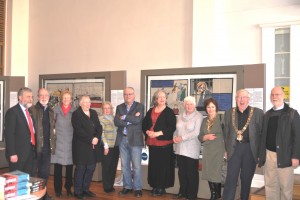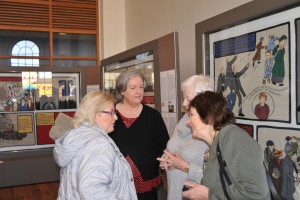Lockout Tapestry on display at Pearse Street Library, Dublin, until March 26th
The 1913 Lockout Tapestry is currently on display at the Dublin City Civic Archive and Public Library in Pearse Street, Dublin. Mary Hunter was one of the core group of stitchers. She is also a leading member of the Medical Laboratory Laboratory Scientists. She recently told the story of her involvement in the making of the Tapestry to her colleagues in the MLSA.

Lord Mayor Christy Burke, SIPTU General President Jack O’Connor, artist Robert Ballagh and Volunteers who worked on the Tapestry. with Mary Hunter on Robert Ballagh’s left.
The 1913 Lockout Tapestry is an ambitious, large-scale collaborative visual arts project to commemorate the Dublin Lockout. When the idea for the Lockout Tapestry was first mooted it was decided it would have to be community based and involve people in reclaiming their own past rather than simply commissioning a work of art. Two of the country’s leading artists, Cathy Henderson, who passed away in October 2014, and Robert Ballagh designed a narrative based on a timeline provided by historian Padraig Yeates. Retired SIPTU activists Brendan Byrne and Michael Halpenny provided much of the organisational expertise, and Angela Keane from the National College of Art and Design provided technical advice to groups working on the panels. However, the crucial element in commemorating this epic story was the involvement of over 200 volunteers who were drawn from schools, trade unions, community activists and above all from the arts and crafts sector.

Left to Right: Mary Enright, Mary Hunter, Tess Flynn and Bernie Murphy at the launch of the Exhibition. The Tapestry will be on display until March 26th. Admission Free.
One of those volunteers was our own Mary Hunter, a Senior Medical Scientists in the Laboratory in Holles Street Hospital and a long time activist in the MLSA.
My introduction to this wonderful project was when the artists Robert Ballagh and Cathy Henderson, along with representatives from SIPTU, came to an Irish Patchwork Society (IPS) meeting to ask for our co-operation in a new community project. I was intrigued because the ‘tapestry’ was not presented as a completed project ready to be stitched, but as an organic project which it appeared would grow with those who were taking part. This also presented an opportunity to work with well know artists on a project where one of the commissioning bodies is a union, an organisation not usually associated with art.
There was also the historical context, the centenary of the 1913 lockout, and perhaps a little irony as we were once again going through employment difficulties. Probably the most important reason for many of us was the challenge of interpreting the artists’ ideas in stitch, combining fine art and craft. Many of the groups that had been asked to take part met up in Tara House on Tara Street for the first meeting in July 2012. The panel that was being discussed on that day was the Bloody Sunday panel and there were many ideas put forward on how this should be approached. Two of the IPS groups went away with samples of the fabrics to be used and a tracing of a section of the panel and set about interpreting it in fabric and stitch. The samples were brought back a couple of weeks later and they were so alike that the two groups decided to work together and we continued to do this every Wednesday evening for fifteen months. A tapestry is traditionally woven, however the 1913 ‘tapestry’ employs many different methods of translating the artist image onto the background linen fabric. Our panels have used many of the methods employed by traditional stitchcraft, patchwork, quilting, appliqué, embroidery and some not so traditional – fabric painting. Each panel took a long time, and all presented their own challenges. On Wednesday evenings up to nine of us worked on some aspect, either the sampling, stitching or discussing with other groups methods that can be used. Adding up the hours working with all none present, the time spent was 18 hours (I have allowed for tea breaks) On occasions the panel was taken home to be worked on but I have not added in these hours. There were some moments of trepidation also.
In the Bloody Sunday panel the policemen were constructed in sections and put back together like a jigsaw. It took some time for one of us to be brave enough to cut out the individual pieces. Thankfully there were no hitches and when they were applied to the background the panel came alive. When the President launched this project in Liberty Hall on November 6th 2013, the Bloody Sunday panel, although not quite finished, was one of a number of panels shown. For all of us there was a great sense of pride and achievement when we heard the very positive reaction to it and watched it being photographed. There were also a number of meetings in Liberty hall as all the groups got together to show their work and it was here that became evident the extent to which the tapestry community had grown. This was a big project! When we had finished to Bloody Sunday Panel we were reluctant to leave and were hoping to remain until the end so we gladly agreed to tackle the Church Street panel when asked.
The diversity of the people taking part in this community project was amazing from those of us who stitch either as a hobby or professionally to those who have never held a needle in their hand. There were those who were involved in rehabilitation groups, prisons, community groups, schools and those who just decided they wanted to take part. Reflecting back on the months we were working on the panel there were many times when the lives of those living through the lockout were talked about, especially when working on the Church Street panel. I remember the tenements on Gardiner Street and I cannot imagine the poverty and hardship suffered during 1913. Many people we met while working on the project or coming to see it during that time had family stories of their own to tell. I have learnt a lot and feel that those who went through the suffering in 1913 will be honoured properly one hundred year later and their part in the formation of the legislation that we work with today will be recognised. The project, all 31panels, has been on display in a number of places now and each time I see it I think about the new friendships that have been formed, the new life skills learnt. In one hundred years will people be curious about our motives for taking part in this important commemorative community project. Thanks to those who imagined the project, those who commissioned it, those who’s patience with the diverse groups made sure the project was completed and those who now continue to support it so that the public can see this historical document. Sadly Cathy Henderson passed away in September 2014 and it is with great fondness and admiration that she will be remembered”.
